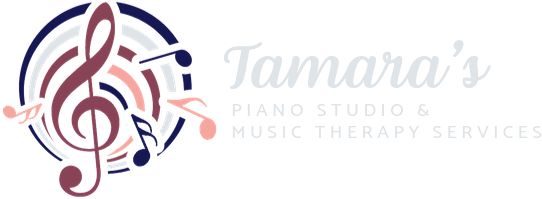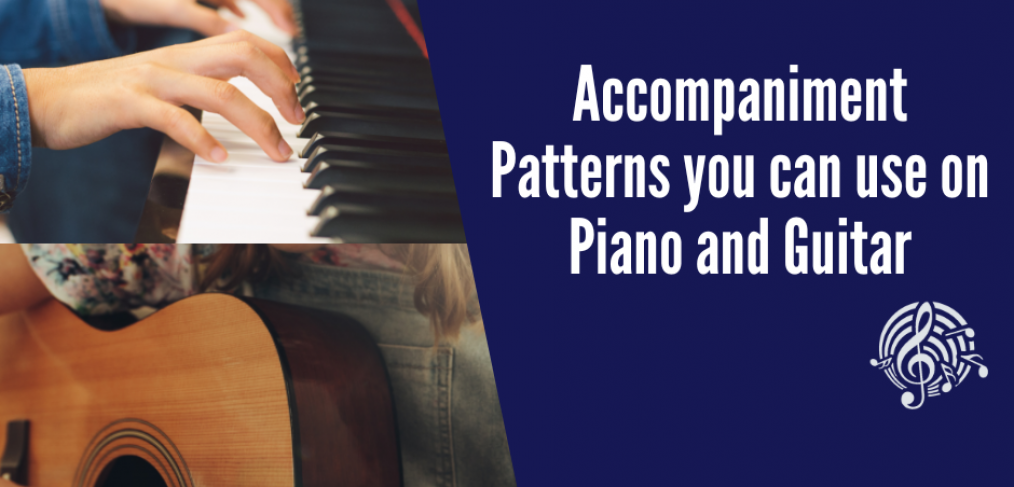The guitar and piano are some of the most popular instruments music therapist use in their sessions. A very simple pattern that a lot of people use is playing 4 quarter notes and singing over it. Although this pattern is great and very simple, what are some other accompaniment patterns you can use that are more interesting?
Here are some accompaniment patterns that I have found useful in my music therapy sessions.
Piano
Left Right Pattern
The Left Right pattern, is an alternating pattern between the left and right hand. It is a very simple and popular pattern you can use for many songs. You can also use this pattern a lot for upbeat songs and nursery rhymes.
Syncopated patterns
Sometimes to make the music aspect of the session different or more interesting, I like to incorporate syncopated patterns. It changes the session up and can also make it more interesting. Sometimes you can also use syncopated patterns to fill up space when playing pop songs as well. This can make the song sound a lot more intermediate than it really does.
Rock Shuffle Pattern
This pattern is a pattern that was introduced to me a few years ago, you can play this pattern in your left hand while playing a simple melody in your right hand, eg: Twinkle Twinkle Little Star. This type of style is a new style that can also add variety in your sessions. When playing this pattern there needs to be a groove in your left hand. “The eighth notes are swung or shuffled” (Johnny) It kind of feels like a long-short pattern. Think triplets, and the first note is a quarter note, and the last note is an eighth note (Johnny).
Below is an example of how you can play it in your left hand.
Alternating pattern/Arpeggio Pattern – Left Hand
This pattern is a simple pattern that can be used for slower and calmer songs eg: ballads. This pattern can also be used to fill space throughout the song, or when transition from a verse to a chorus or vice versa. “One interesting fact about the word arpeggio is that it originates from the Italian word “arpeggiare” which means “to play on a harp”.” (Hoffman Academy Team). Harp players play a lot of arpeggio chords when they are strumming on the strings.
Alternating pattern/Arpeggio Pattern – Right Hand + Left Hand
Arpeggio pattern can also be done by both hands. They are also a great way to help build up dexterity in fingers.
Guitar
The guitar is something that I picked up when my music therapy journey began. The guitar has been referred to as one of the principal and essential instruments in music therapy (Kennedy, 2001, 2003; Lrout, 2003) (Krout). It is also a popular instrument as they are relatively accessible and easy to transport. Here are a few patterns that I have found useful in my sessions.
Syncopated Pattern
This pattern is a pattern that I have found very popular. It can be used across many songs, and also a very simple strumming pattern to pick up on the guitar. This pattern is quite upbeat and can also be used for a lot of fast-paced songs.
Chuck Style
“Chucking” is a common technique with acoustic guitar, where open strums and dead note “chucks” are alternated to create a rhythmic pattern, and it is a primary technique used for playing chords and single notes in creating funk guitar rhythm parts” (Sweetwaters). This strumming pattern is a pattern I found very useful to learn for my therapy sessions as it changes the session musically, and can also make it more interesting.
Here is a video to learn how to chuck on the guitar:
If some of these patterns are confusing, I always like to start simple. 4 quarter notes, then slowly add more variety when you become more familiar with the simple patterns. Simplify everything first. When learning things on the piano I always like to use the LH as a grounding bass to keep rhythm. Of course, there are other patterns on the guitar and piano, but hopefully these patterns will help!
Works Cited:
Harmony, Heart And. “Simple Accompaniment Patterns on Piano | Heart and Harmony Music Therapy.” Heart and Harmony Music Therapy, 3 July 2022, www.heartandharmony.com/simple-accompaniment-patterns-on-piano
“How to Play a Blues Shuffle for Beginner Piano.” Piano with Jonny, 14 Apr. 2021, Pianowithjonny.com/piano-lessons/how-to-play-a-blues-shuffle-for-beginner-piano/.
“How to Play Easy Piano Arpeggios.” Hoffman Academy, 1 Feb. 2024, www.hoffmanacademy.com/blog/how-to-play-easy-piano-arpeggios.
Krout, Robert. (2007). The attraction of the guitar as an instrument of motivation, preference, and choice for use with clients in music therapy: A review of the literature. The Arts in Psychotherapy. 34. 36-52. 10.1016/j.aip.2006.08.005.
Sweetwater. “Chucking – inSync.” inSync, 9 June 2016, www.sweetwater.com/insync/chucking.









